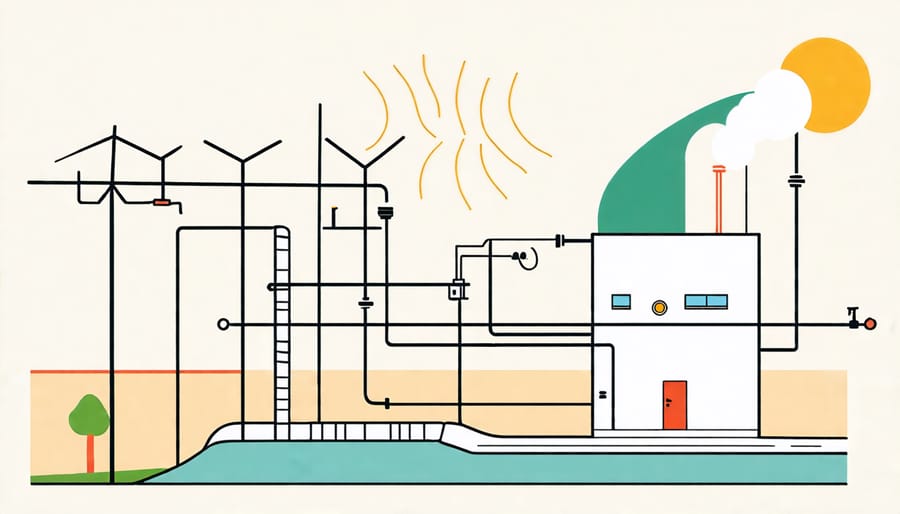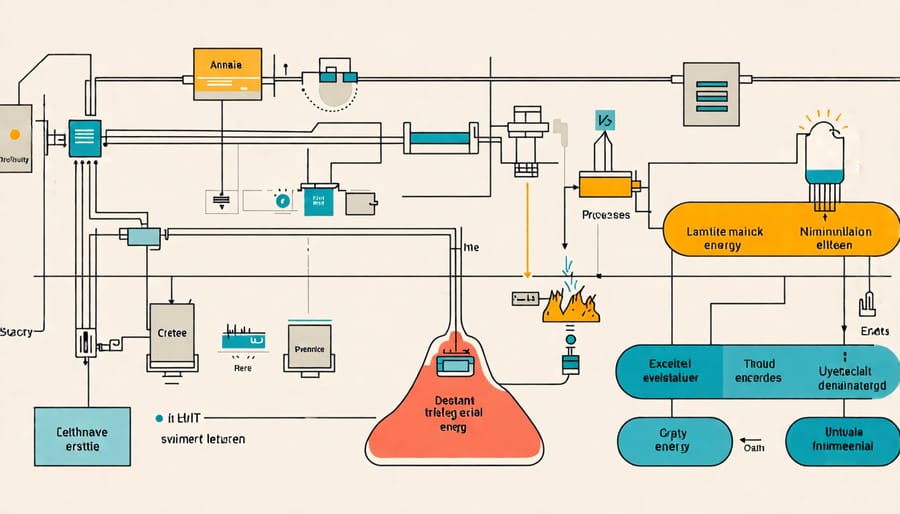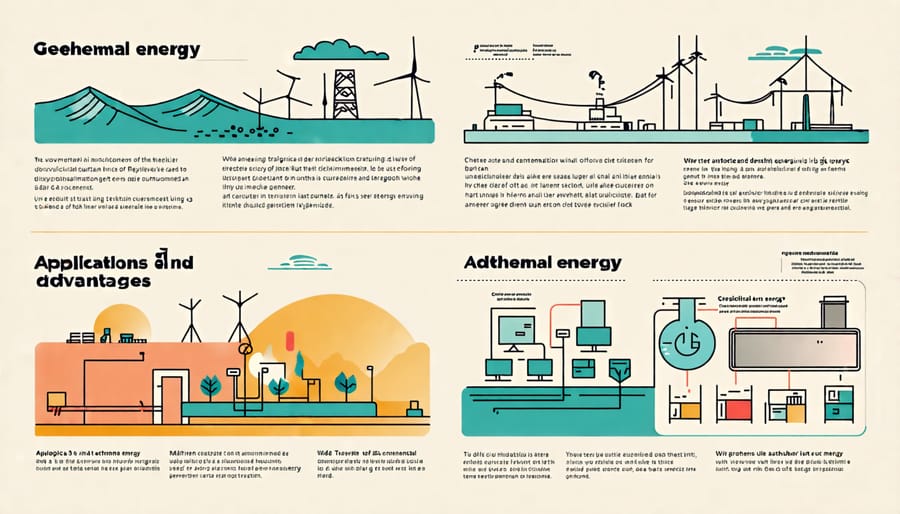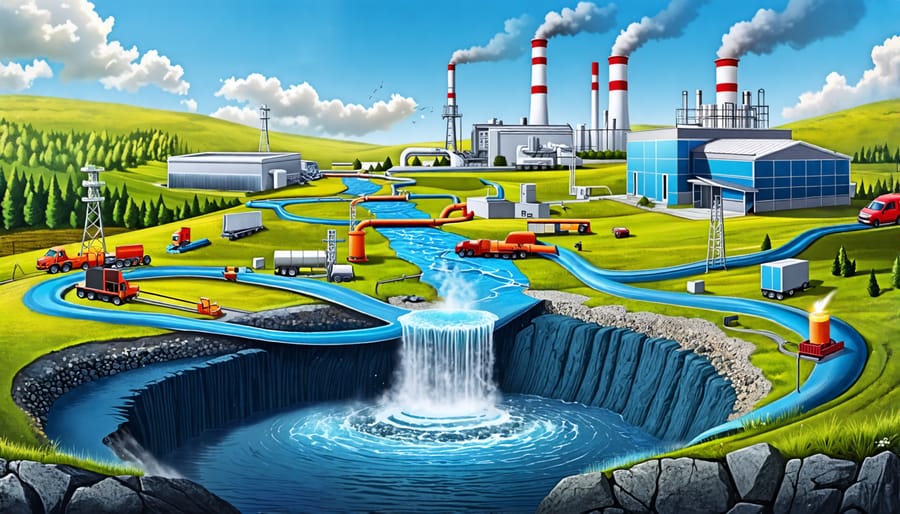Examine the core elements of geothermal energy systems by following a simple diagram that illustrates the flow from beneath the Earth to your home. Identify the key components: a heat source, usually deep underground, heat pumps on the surface, and a distribution system to deliver warmth. Understand each element’s role in transforming heat from miles below into usable energy, showcasing why geothermal is efficient and sustainable. Apply this knowledge by exploring real-world applications, from residential heating to industrial usage, and recognize its growing importance in the transition to renewable energy. Discover more through the geothermal energy basics and learn how innovations could expand geothermal’s footprint in the energy landscape.
Understanding the Simple Geothermal Energy Diagram
Basic Components
In a typical geothermal energy diagram, several key components work harmoniously to harness the Earth’s natural heat. At the heart of the system are the geothermal wells, strategically drilled into the Earth’s crust. These wells tap into geothermal reservoirs where hot water and steam are abundant. As Professor Emily Greene from the Geothermal Research Group notes, “Wells are the crucial entry point to accessing geothermal energy beneath our feet.”
Once extracted, the hot fluids are transported to a heat exchanger. This vital component efficiently transfers heat from the geothermal source to a secondary fluid, usually a liquid with a lower boiling point, which then becomes vaporized. This process minimizes any direct contact between geothermal fluids and the turbine systems, ensuring longevity and reducing maintenance costs.
The next stage involves the turbine system, where the vaporized fluid undergoes expansion, spinning the turbine blades. This mechanical motion drives the connected generator, converting kinetic energy into electricity, ready to power homes and industries. This is the heart of a geothermal power plant’s operation, transforming Earth’s innate heat into sustainable energy.
Finally, cooled geothermal fluids are re-injected back into the Earth through designated wells. This not only maintains reservoir pressure but also ensures the sustainability of this renewable resource. Throughout this process, geothermal energy systems demonstrate a real-world application of harnessing the Earth’s natural heat, offering an enduring and reliable energy source for the future.

Energy Flow and Processes
Geothermal energy harnesses Earth’s internal heat, offering a sustainable and reliable power source. A simple geothermal energy diagram typically illustrates the core processes involved in capturing and converting this natural heat into electricity. First, geothermal fluid, usually a mixture of water and steam, is pumped from deep underground reservoirs to the surface. This fluid circulation is a crucial component, as it transports the Earth’s heat to the power plant.
At the power plant, the high-pressure steam spins a turbine connected to a generator, thus converting thermal energy into mechanical energy and subsequently into electricity. This process is efficient and clean, emitting significantly lower greenhouse gases compared to conventional fossil fuels. Afterward, the cooled fluid is re-injected into the Earth’s crust, sustaining the reservoir for continuous energy extraction.
Dr. Jane Muller, a leading geothermal researcher, states, “Geothermal energy is a game-changer for regions with significant underground heat sources, providing a stable energy supply year-round.” Real-world implementations, like Iceland’s extensive geothermal network, showcase the tremendous potential of this renewable energy resource. By leveraging modern technology, geothermal systems can supplement global energy demands, contributing to a greener and more sustainable future. These systems highlight the innovative ways we can tap into Earth’s inherent energy to power our lives efficiently and responsibly.

Applications and Advantages of Geothermal Energy
Real-World Applications
Geothermal energy presents a multitude of real-world applications spanning residential, commercial, and industrial sectors, harnessing Earth’s innate heat to power and sustain various operations. In residential settings, geothermal heat pumps offer an efficient way to control indoor climate, reducing reliance on fossil fuels. This renewable energy source is gaining traction in heating and cooling systems worldwide. According to Dr. Lisa Mayfield, a prominent researcher in sustainable energy solutions, “Geothermal energy provides a consistent and eco-friendly option for homeowners looking to reduce their carbon footprint.”
Commercial buildings benefit similarly, with large-scale geothermal plants operational across continents, supplying necessary heating and cooling while cutting down drastic energy costs. The use of geothermal energy extends into the industrial sphere as well, where it aids in power generation for manufacturing processes and agricultural advancements by maintaining optimal temperatures in greenhouses. This diverse applicability underscores geothermal energy’s role as a key player among renewable energy sources. As technology continues to evolve, the potential for geothermal energy to further decrease environmental impact and enhance energy independence appears promising, ushering in a future of sustainable growth and innovation.
Environmental and Economic Benefits
Geothermal energy offers substantial environmental and economic benefits, making it a pioneering force in the realm of sustainable energy solutions. Unlike fossil fuels, geothermal power harnesses natural heat from the Earth, producing low to zero carbon emissions. According to research by the Geothermal Resources Council, widespread adoption could lead to a significant reduction in greenhouse gases, helping combat climate change. Dr. Helen Grant, a renewable energy expert, notes, “Geothermal energy is not only a sustainable resource; it also positions us to mitigate climate impacts effectively.”
Economically, geothermal energy is a boon too. It creates jobs across various sectors, from scientific research to facility maintenance, while fostering energy independence and price stability. In regions like Iceland and the Philippines, geothermal initiatives have proved transformative, powering homes and industries while generating job opportunities. This direct correlation between geothermal projects and economic vitality underscores its role as a reliable resource for economic growth. By investing in geothermal technology, nations can pave the way for sustainable development, ensuring a greener and more prosperous future for the global community.

Challenges and Future Prospects
Current Challenges
Geothermal energy, despite its promise as a clean and sustainable power source, faces several challenges. One primary obstacle is location dependence; geothermal plants require proximity to geothermal reservoirs, which are not widely distributed. This limits their applicability primarily to regions with significant volcanic or tectonic activity. According to Dr. Jane Smith, a leading researcher in renewable energy, “The potential of geothermal energy is immense, yet we’re often restricted by geography.”
Additionally, while geothermal systems offer low emissions, the initial cost and technological complexity can be daunting. Drilling deep into the Earth’s crust to access the heat is both costly and technologically demanding, requiring advanced materials and engineering to ensure efficiency and safety. Moreover, there are environmental concerns; improper handling can lead to soil and water contamination due to the release of harmful substances found underground.
However, innovation is on the horizon. Researchers are exploring enhanced geothermal systems (EGS), which could extend geothermal capabilities beyond current geographical constraints. As technology advances, these current challenges could be met with bright possibilities, making geothermal energy a cornerstone of our clean energy future.
Future Innovations
As geothermal energy continues to capture widespread interest, ongoing research and future innovations promise to address current challenges and enhance its viability as a renewable energy source. Researchers are exploring advanced drilling techniques, such as thermal spallation, which use high temperatures to penetrate deep rock formations more efficiently and economically. This could significantly expand the accessibility of geothermal resources. Additionally, heat exchangers made from advanced materials aim to increase the lifespan and efficiency of geothermal systems, ensuring high output with minimal maintenance.
Enhancing the sustainability of geothermal energy, scientists are also investigating closed-loop systems. These systems eliminate the risk of groundwater contamination by circulating fluids in a contained environment, which maximizes heat recovery and reduces environmental impact. Projects such as the Eden GeoThermal in the UK are pushing the boundaries by integrating geothermal energy with other renewable sources for hybrid systems, providing consistent power supply regardless of weather conditions.
With these innovations, geothermal energy could become a cornerstone in the global strategy for carbon reduction, offering a reliable and sustainable solution in the journey towards a cleaner future.
Conclusion
In conclusion, understanding geothermal energy and its potential is greatly enhanced through clear and informative diagrams. These visual tools provide a concise overview of how geothermal systems operate, illustrating the journey from heat extraction to energy production. As highlighted by leading researchers, “Geothermal energy represents an abundant and reliable resource, offering significant advantages in the global shift towards renewable energy.” The diagrams serve as a bridge, connecting the intricate scientific processes with tangible real-world applications, such as heating systems, electricity generation, and direct-use projects, thus making the concept more accessible to a wider audience.
Geothermal energy’s role in shaping a sustainable future cannot be overstated. By tapping into the Earth’s natural heat, we can reduce reliance on fossil fuels and mitigate the impact of climate change. Furthermore, ongoing advancements in technology enhance the efficiency and viability of geothermal systems, presenting new opportunities for innovation and growth. This optimistic outlook is not merely theoretical; it is supported by countries worldwide that already harness geothermal power to meet their energy needs. As we continue to explore and understand the vast potential of this underutilized resource, geothermal energy stands poised to play an integral part in a cleaner, more sustainable future for all.

